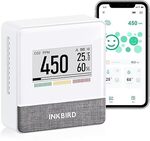I've seen people mention CO2 monitors a few times so I decided to buy one to see what my CO2 levels are when I close my windows and turn on the aircon for the whole day and whether it's worth opening the window a bit.
Review here: https://www.youtube.com/watch?v=A6Fr2_tq5-U
There's also a cheaper model for $70: https://www.amazon.com.au/INKBIRD-Detector-Accurate-Temperat…



 CamelCamelCamel
CamelCamelCamel

For those with a Home Assistant install you can build something similar yourself by modifying an ikea one: https://style.oversubstance.net/2021/08/diy-use-an-ikea-vind…